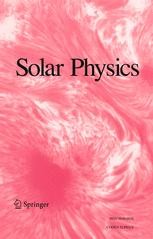Editors' Choice: "Re-analysis of Lepping’s Fitting Method for Magnetic Clouds: Lundquist Fit Reloaded"
 Démoulin, P., Dasso, S., Janvier, M. et al, Re-analysis of Lepping’s Fitting Method for Magnetic Clouds: Lundquist Fit Reloaded, Sol Phys 294, 172 (2019) https://doi.org/10.1007/s11207-019-1564-x
Démoulin, P., Dasso, S., Janvier, M. et al, Re-analysis of Lepping’s Fitting Method for Magnetic Clouds: Lundquist Fit Reloaded, Sol Phys 294, 172 (2019) https://doi.org/10.1007/s11207-019-1564-x
Editor's Choice | Open Access
Published: 11 December 2019
Abstract:
Magnetic clouds (MCs) are a subset of ejecta, launched from the Sun as coronal mass ejections. The coherent rotation of the magnetic field vector observed in MCs leads to envision MCs as formed by flux ropes (FRs). Among all the methods used to analyze MCs, Lepping’s method (Lepping, Burlaga, and Jones in J. Geophys. Res. 95, 11957, 1990) is the broadest used. While this fitting method does not require the axial field component to vanish at the MC boundaries, this idea is largely spread in publications. We revisit Lepping’s method to emphasize its hypothesis and the meaning of its output parameters. As originally defined, these parameters imply a fitted FR which could be smaller or larger than the studied MC. We rather provide a re-interpretation of Lepping’s results with a fitted model limited to the observed MC interval. We find that typically the crossed FRs are asymmetric with a larger side both in size and magnetic flux before or after the FR axis. At the boundary of the largest side we find an axial magnetic field component distributed around zero which we justify by the physics of solar eruptions. In contrast, at the boundary of the smaller side the axial field distribution is shifted to positive values, as expected with erosion acting during the interplanetary travel. This new analysis of Lepping’s results has several implications. First, global quantities, such as magnetic fluxes and helicity, need to be revised depending on the aim (estimating global properties of FRs just after the solar launch or at 1 au). Second, the deduced twist profiles in MCs range quasi-continuously from nearly uniform, to increasing away from the FR axis, up to a reversal near the MC boundaries. There is no trace of outsider cases, but a continuum of cases. Finally, the impact parameter of the remaining FR crossed at 1 au is revised. Its distribution is compatible with weakly flattened FR cross-sections.
Solar Physics Editor's Choice:
In each volume of Solar Physics, a few papers are marked as “Editors’ Choice”. The primary criteria is original, high quality research that is of wide interest within the community.
